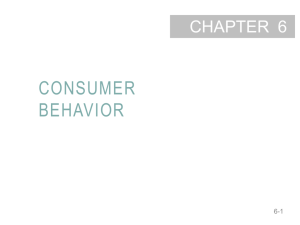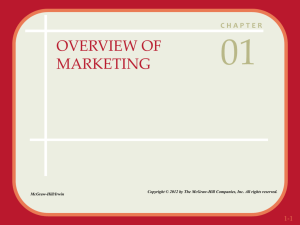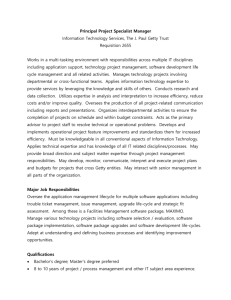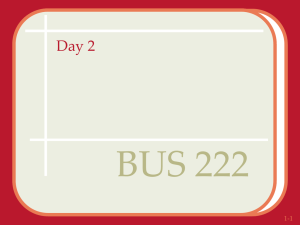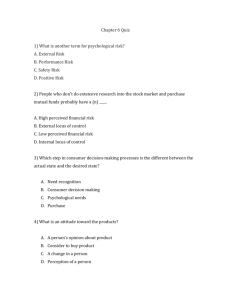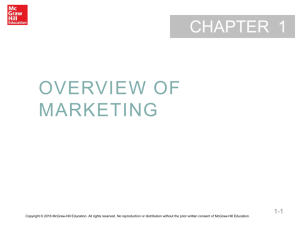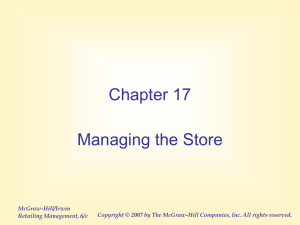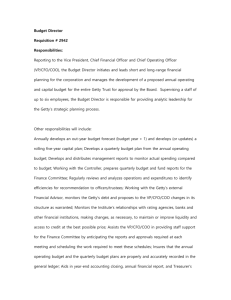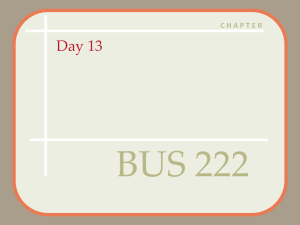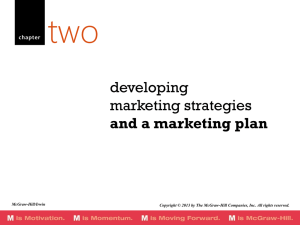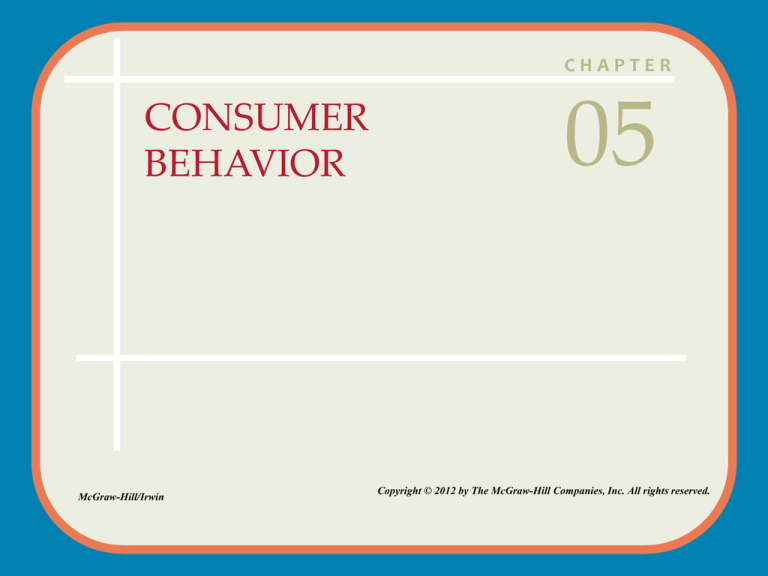
CHAPTER
CONSUMER
BEHAVIOR
McGraw-Hill/Irwin
05
Copyright © 2012 by The McGraw-Hill Companies, Inc. All rights reserved.
Consumer Behavior
LEARNING OBJECTIVES
LO1 Articulate the steps in the consumer buying process.
LO2 Describe the difference between functional and
psychological needs.
LO3 Describe factors that affect information search.
LO4 Discuss post-purchase outcomes.
LO5 List the factors that affect the consumer decision
process.
LO6 Describe how involvement influences the consumer
decision process.
5-2
The Consumer Decision Process
5-3
Need Recognition
Psychological needs
©Digital Vision/PunchStock
Royalty-Free/CORBIS
Functional needs
5-4
Search for Information
Internal Search for
Information
External Search for
Information
5-5
Factors Affecting Consumers’
Search Process
Perceived
Benefits
Perceived
Costs
5-6
The Locus of Control
Internal Locus of Control =
more search activities
Royalty-Free/CORBIS
External Locus of Control =
Fate, external factors
©Comstock/JupiterImages
5-7
Actual or Perceived Risk
Performance
risk
Psychological
risk
Financial risk
5-8
Evaluation of Alternatives:
Attribute Sets
Universal
Retrieval
Evoked
5-9
Evaluation of Alternatives:
Evaluate Criteria
Evaluative Criteria
Determinant
Attributes
Digital Vision/Getty Images
What are some of the features of a vacation that
would be in your evaluative criteria?
5-10
Evaluation of Alternatives:
Consumer Decision Rules
5-11
Evaluation of Alternatives:
Decision Heuristics
Mental
Shortcuts
Price
Brand
Product
presentation
Amos Morgan/Getty Images
5-12
Check Yourself
1.
What is the difference between a need and
a want?
2.
Distinguish between functional and
psychological needs.
3.
What are the various types of perceived
risk?
4.
What are the differences between
compensatory and noncompensatory
decision rules?
5-13
Purchase and Consumption
Increase
Conversion rate
Reduce real or
virtual
abandoned carts
Merchandise in
stock
Reduce the
actual wait time
5-14
Post-purchase: Customer Satisfaction
Customer contact
Encourage feedback
Provide money back guarantee
Demonstrate correct product use
Build realistic expectations
Digital Vision/Getty Images
5-15
Post-purchase: Dissonance
• Firm’s attempt to
reduce dissonance by
reinforcing the
decision
• Thank you letters,
congratulations
letters, quality ratings
©Lars A Niki
5-16
Post-purchase: Customer loyalty
©Lou Cypher/Corbis
• Marketers attempt to
solidify a loyal
relationship.
• Satisfied customers
purchases and buy
from the same
company again.
5-17
Check Yourself
1.
Identify the five stages in the consumer
decision process.
5-18
Factors Influencing
the Consumer Decision Process
5-19
Psychological Factors: Motives
Courtesy Taco Bell
5-20
Psychological Factors: Attitude
Behavioral
Attitude
Cognitive
Affective
©K Rousonelos
5-21
Psychological Factors: Perception
Ryan McVay/Getty Images
How has society’s
perception of
people with tattoos
changed in recent
years?
5-22
Psychological Factors:
Learning and Lifestyle
Learning affects
both attitudes and
perceptions
Lifestyle involves
decisions in
spending time and
money
Royalty-Free/CORBIS
5-23
Social Factors: Family
Digital Vision/Getty Images
5-24
Social Factors: Reference Groups
Groups
Provide:
•Family
•Friends
•Coworkers
•Famous people
•information
•rewards
•self-image
5-25
Social Factors: Reference Groups
Photo by James Devaney/WireImage
GEICO Commercial
5-26
Social Factors: Culture
Royalty-FreeCORBIS
C Squared Studios/Getty Images
C Squared Studios/Getty Images
Geoff Manasse/Getty Images
5-27
Situational Factors
Purchase Situation
Shopping Situation
Courtesy Murphy O’Brien Public Relations/Santa Monica, CA
5-28
Check Yourself
1.
What are the types of needs suggested by
Maslow’s Hierarchy of Needs?
2.
Which social factors likely have the most
influence on:
a.
b.
3.
The purchase of a new outfit for going out
dancing?
The choice of a college to attend?
List some of the tactics stores can use to
influence consumers’ decision processes.
5-29
Involvement and Consumer
Buying Decisions
5-30
Types of Buying Decisions
• Extended Problem Solving
• Limited Problem Solving
– Impulse Buying
– Habitual Decision Making
Courtesy Wendy’s International, Inc.
5-31
Check Yourself
1.
How do low versus high involvement
consumers process information in an
advertisement?
2.
What is the difference between
extended versus limited problem
solving?
5-32

